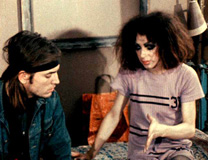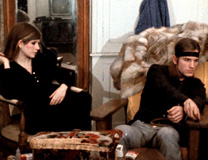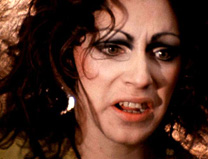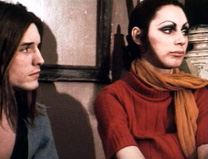It’s probably safe to say that without filmmakers like Paul Morrissey, there would be no independent cinema today. With his documentary style of filmmaking, cast of unprofessional performers, and birds’-eye view of the lower rungs of society, Morrissey made films that Hollywood hadn’t yet warmed up to making. Only in the 1970’s would films start to tackle meatier issues such as drugs, sex, and violence with unflinching realism, and it’s thanks to the success of underground and independent films like TRASH. The influence of Morrissey is especially evident in the recent Dogma filmmaking technique used by Lars von Trier, which can be annoying and ugly when shot on video as opposed to Morrissey’s 16mm camera. After the very primitive FLESH, Morrissey struck back two years later with arguably his finest film. A tad overlong at almost two hours but populated with a vivacious potpourri of characters and simultaneously funny and tragic, TRASH is the film which established Paul Morrissey as a filmmaker.
 Long-haired
heroin addict Joe lives in a cheap basement “apartment” with his
viper-tongued girlfriend Holly. By day he scours the streets of New York for
his next fix, by night he absorbs his smack and crashes in his dwelling with
his faithful pet dog. The monkey on his back has resulted in impotency, so Holly
can only pleasure herself with a beer bottle while Joe watches. After attempting
to get a blowjob from stripper Gerri, he soon finds himself caught up in a whirlwind
of wild bourgeois characters, including a rich heiress with a fetish for LSD
and a newlywed Michigander who begs Joe to rape her and demands to watch him
shoot up. Another tailspin ensues when Holly’s pregnant sister alerts
Holly that the couple can easily get welfare by taking her soon-to-be-born son
as their own. And so begins Holly’s undying quest to fulfill a family
tradition: get on welfare!
Long-haired
heroin addict Joe lives in a cheap basement “apartment” with his
viper-tongued girlfriend Holly. By day he scours the streets of New York for
his next fix, by night he absorbs his smack and crashes in his dwelling with
his faithful pet dog. The monkey on his back has resulted in impotency, so Holly
can only pleasure herself with a beer bottle while Joe watches. After attempting
to get a blowjob from stripper Gerri, he soon finds himself caught up in a whirlwind
of wild bourgeois characters, including a rich heiress with a fetish for LSD
and a newlywed Michigander who begs Joe to rape her and demands to watch him
shoot up. Another tailspin ensues when Holly’s pregnant sister alerts
Holly that the couple can easily get welfare by taking her soon-to-be-born son
as their own. And so begins Holly’s undying quest to fulfill a family
tradition: get on welfare!
 TRASH
succeeds as the story of a drug addict meandering through life day to day, but
is even better when examining the love story between Joe and Holly. Both are
presented in scenarios questioning their love for one another (Joe with the
pregnant sister, Holly with the teenager), but also are seen in moving scenes
showing their true affection for one another (Joe cleaning up the basement for
Holly, Holly with great heartache after discovering Joe and her sister). Unlike
Joe and Geri in FLESH, Joe and Holly make an intriguing couple that carries
the film easily. In fact, their relationship is so fascinating that Joe’s
scenes with the rich leeches he encounters seem unnecessary. Does Joe know Holly
is a transvestite? It’s never made clear whether Joe is gay or bisexual
and the two “men” are in love, or Holly is actually a woman and
the two are a heterosexual couple, or if Joe is a straight boy fooled into thinking
Holly is a woman. Whatever the explanation, they form the solid core of TRASH
and raise it above the simple exterior of being an X-rated underground shock
feature.
TRASH
succeeds as the story of a drug addict meandering through life day to day, but
is even better when examining the love story between Joe and Holly. Both are
presented in scenarios questioning their love for one another (Joe with the
pregnant sister, Holly with the teenager), but also are seen in moving scenes
showing their true affection for one another (Joe cleaning up the basement for
Holly, Holly with great heartache after discovering Joe and her sister). Unlike
Joe and Geri in FLESH, Joe and Holly make an intriguing couple that carries
the film easily. In fact, their relationship is so fascinating that Joe’s
scenes with the rich leeches he encounters seem unnecessary. Does Joe know Holly
is a transvestite? It’s never made clear whether Joe is gay or bisexual
and the two “men” are in love, or Holly is actually a woman and
the two are a heterosexual couple, or if Joe is a straight boy fooled into thinking
Holly is a woman. Whatever the explanation, they form the solid core of TRASH
and raise it above the simple exterior of being an X-rated underground shock
feature.
 It’s
interesting to know that the man directing this anti-drug fable was one of the
cleanest, squarest talents to come out of Warhol’s Factory. Morrissey
has gone on record about his dislike for the massive intake of drugs by his
contemporaries, and his unflinching photography of Dallesandro’s shoot-up
scenes are still the most effective ever committed to celluloid. According to
Dallesandro, he used ordinary tap water and received a swarm of letters to the
Factory by filmgoers who thought he was a genuine junkie, begging him to quit.
Dallesandro seems appropriately lost in a whirlwind of activity during most
of the film, which unfortunately makes his performance the least interesting
in comparison to the wild characters he meets, but he is still impressive in
several dramatic scenes and of course had no issues with nudity. His real-life
brother Bob plays his junkie friend.
It’s
interesting to know that the man directing this anti-drug fable was one of the
cleanest, squarest talents to come out of Warhol’s Factory. Morrissey
has gone on record about his dislike for the massive intake of drugs by his
contemporaries, and his unflinching photography of Dallesandro’s shoot-up
scenes are still the most effective ever committed to celluloid. According to
Dallesandro, he used ordinary tap water and received a swarm of letters to the
Factory by filmgoers who thought he was a genuine junkie, begging him to quit.
Dallesandro seems appropriately lost in a whirlwind of activity during most
of the film, which unfortunately makes his performance the least interesting
in comparison to the wild characters he meets, but he is still impressive in
several dramatic scenes and of course had no issues with nudity. His real-life
brother Bob plays his junkie friend.
 While
Dallesandro was the poster boy for TRASH and gives a convincing performance
as a drug addict with a multi-layered relationship with his girlfriend, TRASH
belongs almost completely to Holly Woodlawn. Born Harold Danhakl in Puerto Rico,
Harold became Holly in New York City and was cast in the film after giving an
outrageous interview to an underground newspaper where she claimed to be friends
with Andy Warhol. The two had never met! Morrissey admired her ballsiness and
cast her in one scene establishing her as Joe’s girlfriend, and thought
she handled it so well that he made her role larger. So large in fact that Holly
steals the film from out from under her muscular co-star! Holly’s performance
is laugh out loud funny, yet poignant and heartbreaking. It takes a gifted actress
to provoke laughter from her outrageous seduction of a teenager in one scene
(her real-life boyfriend Johnny Putnam), then draw tears as she feels hurt and
betrayed after walking in on Joe making it with her pregnant sister. Unlike
fellow drag Superstars Jackie Curtis and Candy Darling, Holly comes across as
a believable woman because she doesn’t overdo the glamour aspect of drag.
Why didn’t Holly take off and break the barrier between Hollywood and
underground, man and woman? She was on her way after TRASH, even coming close
to getting a Best Supporting Actress Oscar nomination for her work in the film,
but as with many rising stars, the bottle left her slumming in underground films
by Morrissey imitators. She is the sole surviving Warhol drag queen Superstar
and her book A Lowlife in High Heels is mandatory reading for those
interested in Woodlawn and her days in the Factory.
While
Dallesandro was the poster boy for TRASH and gives a convincing performance
as a drug addict with a multi-layered relationship with his girlfriend, TRASH
belongs almost completely to Holly Woodlawn. Born Harold Danhakl in Puerto Rico,
Harold became Holly in New York City and was cast in the film after giving an
outrageous interview to an underground newspaper where she claimed to be friends
with Andy Warhol. The two had never met! Morrissey admired her ballsiness and
cast her in one scene establishing her as Joe’s girlfriend, and thought
she handled it so well that he made her role larger. So large in fact that Holly
steals the film from out from under her muscular co-star! Holly’s performance
is laugh out loud funny, yet poignant and heartbreaking. It takes a gifted actress
to provoke laughter from her outrageous seduction of a teenager in one scene
(her real-life boyfriend Johnny Putnam), then draw tears as she feels hurt and
betrayed after walking in on Joe making it with her pregnant sister. Unlike
fellow drag Superstars Jackie Curtis and Candy Darling, Holly comes across as
a believable woman because she doesn’t overdo the glamour aspect of drag.
Why didn’t Holly take off and break the barrier between Hollywood and
underground, man and woman? She was on her way after TRASH, even coming close
to getting a Best Supporting Actress Oscar nomination for her work in the film,
but as with many rising stars, the bottle left her slumming in underground films
by Morrissey imitators. She is the sole surviving Warhol drag queen Superstar
and her book A Lowlife in High Heels is mandatory reading for those
interested in Woodlawn and her days in the Factory.
 Geri
Miller from FLESH returns as a stripper friend of Joe’s who tries to help
him with his impotency. Harkening back to her discussion of breast implants
using either silicone or plant juice, Miller sports two enlargened mammaries
which are displayed during her strip routine on her personal stage with flashing
lights and curtains. Playing over this scene is a song that sounds very much
like she recorded it herself called “Mama Look at Me Now.” It could
have been a hit! According to Warhol’s “Diaries”, the last
he (or anyone) heard from her was a bizarre 1985 phone call from a womens’
shelter; she had succumbed to schizophrenia and was screaming racial slurs at
the minorities surrounding her. A sad fate for a funny, bubbling, and tragic
character.
Geri
Miller from FLESH returns as a stripper friend of Joe’s who tries to help
him with his impotency. Harkening back to her discussion of breast implants
using either silicone or plant juice, Miller sports two enlargened mammaries
which are displayed during her strip routine on her personal stage with flashing
lights and curtains. Playing over this scene is a song that sounds very much
like she recorded it herself called “Mama Look at Me Now.” It could
have been a hit! According to Warhol’s “Diaries”, the last
he (or anyone) heard from her was a bizarre 1985 phone call from a womens’
shelter; she had succumbed to schizophrenia and was screaming racial slurs at
the minorities surrounding her. A sad fate for a funny, bubbling, and tragic
character.
 Morrissey
introduces two grating new personalities in TRASH: Andrea Feldman and Jane Forth.
Feldman, aka Andrea Whips, was a certified nutjob, according to Factory residents,
who would frequently boff her clothing to dance topless on restaurant tables
and scream strange phrases like “You’re nothing! You’re going
nowhere!” or “I think it’s time for Showtime!”. Was
she a true life mental patient? It’s quite possible, and not hard to believe
after watching her performance in TRASH. Feldman plays the rich girl picked
up by Joe on the street, who begs him for some LSD before insisting on watching
him shoot up. She rambles endlessly about her rich bitch mother, says she sees
crabs crawling through Joe’s pubic hair, and provokes him into raping
her. This irritating introduction to Feldman is a far cry from her very funny
co-starring role in HEAT two years later. Forth, a porcelain doll beauty, must
have seen her role as a spoiled newlywed from Gross Pointe, Michigan, as her
major bid for stardom and bites into this role with relish. To put it bluntly,
she never shuts up! Dallesandro seems visibly taken aback by the non-stop verbal
assault she throws his way, and his surprise at her asking if he gives good
rim jobs is priceless. She actually delivers some of the best lines in TRASH,
bitching and moaning to her husband about their crumbling marriage. Co-star
Bruce Pecheur (CRY UNCLE!) gives as good as he gets, resulting in some of the
funniest screen sparring outside of HIS GIRL FRIDAY. Forth would return for
Morrissey’s ill-fated L’AMOUR, had a bit part as a woman splashed
by baby blood in ANDY WARHOL’S BAD (see it to understand what that means),
and is currently living near Woodstock, NY. Rounding out the cast is Michael
Sklar, who really gets into the role of the high and mighty welfare worker who
gives the couple an ultimatum: Holly’s beautiful shoes for his collection
or no welfare. A shouting match and multiple insults later, guess which the
couple chooses. On first glance, it’s a devastating finale, but it soon
becomes apparent that as long as Holly and Joe have each other, that’s
all they need.
Morrissey
introduces two grating new personalities in TRASH: Andrea Feldman and Jane Forth.
Feldman, aka Andrea Whips, was a certified nutjob, according to Factory residents,
who would frequently boff her clothing to dance topless on restaurant tables
and scream strange phrases like “You’re nothing! You’re going
nowhere!” or “I think it’s time for Showtime!”. Was
she a true life mental patient? It’s quite possible, and not hard to believe
after watching her performance in TRASH. Feldman plays the rich girl picked
up by Joe on the street, who begs him for some LSD before insisting on watching
him shoot up. She rambles endlessly about her rich bitch mother, says she sees
crabs crawling through Joe’s pubic hair, and provokes him into raping
her. This irritating introduction to Feldman is a far cry from her very funny
co-starring role in HEAT two years later. Forth, a porcelain doll beauty, must
have seen her role as a spoiled newlywed from Gross Pointe, Michigan, as her
major bid for stardom and bites into this role with relish. To put it bluntly,
she never shuts up! Dallesandro seems visibly taken aback by the non-stop verbal
assault she throws his way, and his surprise at her asking if he gives good
rim jobs is priceless. She actually delivers some of the best lines in TRASH,
bitching and moaning to her husband about their crumbling marriage. Co-star
Bruce Pecheur (CRY UNCLE!) gives as good as he gets, resulting in some of the
funniest screen sparring outside of HIS GIRL FRIDAY. Forth would return for
Morrissey’s ill-fated L’AMOUR, had a bit part as a woman splashed
by baby blood in ANDY WARHOL’S BAD (see it to understand what that means),
and is currently living near Woodstock, NY. Rounding out the cast is Michael
Sklar, who really gets into the role of the high and mighty welfare worker who
gives the couple an ultimatum: Holly’s beautiful shoes for his collection
or no welfare. A shouting match and multiple insults later, guess which the
couple chooses. On first glance, it’s a devastating finale, but it soon
becomes apparent that as long as Holly and Joe have each other, that’s
all they need.
 In
another wonderful improvement over their previous out of print snap case disc,
Image has remastered TRASH from its original negative in a hi-def transfer that
presents the film looking better than ever. As with the FLESH transfer, some
of the reds are a bit strong and bleed a little, but the image is clear and
bright and skintones accurate. Blacks are deep, and other colors vivid. Grain
is mild during most scenes (some indoor scenes suffer because of bad lighting)
but for the most part the film is very clear. The photography was shot, as with
Morrissey’s other films, in a documentary style, with out of focus shots,
frequent zooms, odd framing, and constant movement, but the film that will never
look like a million dollars comes pretty close. The mono audio was recorded
as best as possible, but still isn’t excellent because of the shooting
conditions. All the dialogue comes across clearly enough, especially the strong
shouting. The opening and closing credits feature two golden oldies a la FLESH:
two musical themes from Josef von Stenberg’s THE BLUE ANGEL, and both
sound great. Those who own the previous Image disc of TRASH may want to hold
onto it. While that disc includes the full-length BLUE ANGEL theme, both the
French Carlotta Films boxed set version and this new Image edition cut off the
music to allow the opening shots of Joe’s derriere during fellatio to
play out silent. It’s unclear whether that was Morrissey’s intention,
but the film plays better with music over this sequence. Otherwise all around
this is the best edition of TRASH released to date.
In
another wonderful improvement over their previous out of print snap case disc,
Image has remastered TRASH from its original negative in a hi-def transfer that
presents the film looking better than ever. As with the FLESH transfer, some
of the reds are a bit strong and bleed a little, but the image is clear and
bright and skintones accurate. Blacks are deep, and other colors vivid. Grain
is mild during most scenes (some indoor scenes suffer because of bad lighting)
but for the most part the film is very clear. The photography was shot, as with
Morrissey’s other films, in a documentary style, with out of focus shots,
frequent zooms, odd framing, and constant movement, but the film that will never
look like a million dollars comes pretty close. The mono audio was recorded
as best as possible, but still isn’t excellent because of the shooting
conditions. All the dialogue comes across clearly enough, especially the strong
shouting. The opening and closing credits feature two golden oldies a la FLESH:
two musical themes from Josef von Stenberg’s THE BLUE ANGEL, and both
sound great. Those who own the previous Image disc of TRASH may want to hold
onto it. While that disc includes the full-length BLUE ANGEL theme, both the
French Carlotta Films boxed set version and this new Image edition cut off the
music to allow the opening shots of Joe’s derriere during fellatio to
play out silent. It’s unclear whether that was Morrissey’s intention,
but the film plays better with music over this sequence. Otherwise all around
this is the best edition of TRASH released to date.
 One-upping
the barebones edition of TRASH, Image has included a decent selection of extras,
all with the help of Paul Morrissey himself. A selection of deleted scenes includes
an extension of the dialogue scene between Joe and Holly’s teenage pick-up
and an alternate take of Holly and Joe talking to the welfare worker. Morrissey
provides commentary over the scenes, explaining why they were cut. A stills
gallery is included with Morrissey commentary, but as with the FLESH disc, it’s
simply too short and doesn’t offer enough anecdotes about making the film
and casting each unique performer. A selected scenes commentary with Morrissey
may have been a wiser choice. Considering that Morrissey’s similar gallery
commentaries on BLOOD FOR DRACULA and FLESH FOR FRANKENSTEIN were almost half
an hour long, it’s disappointing that these far more interesting films
only receive three and a half minutes of time. Interviews with Joe Dallesandro,
Holly Woodlawn, and Jane Forth would have been wonderful, but thankfully fans
can check out Little Joe Superstar and A Lowlife in High Heels
to read the memories of Dallesandro and Woodlawn.
One-upping
the barebones edition of TRASH, Image has included a decent selection of extras,
all with the help of Paul Morrissey himself. A selection of deleted scenes includes
an extension of the dialogue scene between Joe and Holly’s teenage pick-up
and an alternate take of Holly and Joe talking to the welfare worker. Morrissey
provides commentary over the scenes, explaining why they were cut. A stills
gallery is included with Morrissey commentary, but as with the FLESH disc, it’s
simply too short and doesn’t offer enough anecdotes about making the film
and casting each unique performer. A selected scenes commentary with Morrissey
may have been a wiser choice. Considering that Morrissey’s similar gallery
commentaries on BLOOD FOR DRACULA and FLESH FOR FRANKENSTEIN were almost half
an hour long, it’s disappointing that these far more interesting films
only receive three and a half minutes of time. Interviews with Joe Dallesandro,
Holly Woodlawn, and Jane Forth would have been wonderful, but thankfully fans
can check out Little Joe Superstar and A Lowlife in High Heels
to read the memories of Dallesandro and Woodlawn.
Related links:
Please visit the divine Miss Holly Woodlawn at www.hollywoodlawn.com
and let her know what you thought of her performance!
Lovers of Geri Miller will enjoy reading a vintage interview with her at this link: http://www.warholstars.org/warhol/warhol1/warhol1c/warhol1cl/gerimiller.html
For all the dirt on the making of Morrissey’s films and the people in them, visit http://www.warholstars.org (Casey Scott)